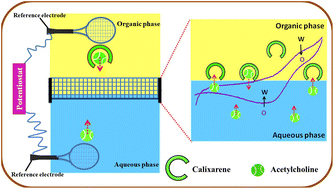Disposable-micropipette tip supported electrified liquid–organogel interface as a platform for sensing acetylcholine†‡
Abstract
Sensing acetylcholine has been predominantly based on enzymatic strategies using acetylcholine esterase and choline oxidase because of its electrochemical inertness. Electrified liquid–liquid interfaces are not limited to oxidation/reduction processes, and can be utilized to detect non-redox molecules which cannot be detected using conventional solid electrodes. In this study, a disposable micropipette tip based liquid–organogel interface, in the presence/absence of calixarene has been developed as a platform for sensing acetylcholine. We also explored a liquid–liquid interface approach for sensing acetylcholine using a pre-pulled glass micropipette. In both approaches, the configuration, i.e., liquid–organogel and liquid–liquid interface-current linearly increases during the backward transfer of acetylcholine. The simple and facilitated ion transfer of acetylcholine across the liquid–organogel exhibited a linear range of 10–50 μM and 1–30 μM with a detection limit of 0.18 μM and 0.23 μM and a sensitivity of 9.52 nA μM−1 and 9.20 nA μM−1, respectively. Whereas, the detection limit of simple and facilitated ion transfer of liquid–liquid interface using pre-pulled glass micropipette was found to be 0.42 μM and 0.13 μM with a sensitivity of 5 × 10−3 nA μM−1 and 3.39 × 10−2 nA μM−1. The results indicate that the liquid–organogel configuration supported on a disposable micropipette tip without any pre-fabrication is highly suitable for electrified soft interface sensing applications.



 Please wait while we load your content...
Please wait while we load your content...